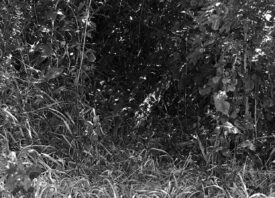Search this site
A Teen Photographer Races to Protect a Massachusetts Forest


The teen photographer Soren Goldsmith spent his childhood exploring the woods and wetlands of Belmont, Massachusetts. By the time he was in high school, he’d started photographing them too. One spring, he visited the same patch of woods each afternoon, returning time and again to watch a pair of Great Horned owls, listening to them hooting back and forth just before the sun hit the horizon.

Another time, three years ago, he spent the night on the side of the road, freezing, waiting for the animals—foxes, rabbits, coyotes, and more—to emerge after all the humans had gone to sleep. That night, he saw coyotes pass by in a blur before one of them returned and they crossed paths once more. Their eyes met in the dark before the animal went on his way.

This land, where Goldsmith grew up and discovered his passion for wildlife photography, is currently under threat. The Belmont Hill School, which owns the land, has plans to clearcut the woods to make way for a parking lot and mechanical facility, despite a petition signed by more than 2,800 people to stop the development.
Since the announcement of those plans, Goldsmith’s work has taken on a new kind of urgency. Using camera traps, he’s been able to capture images of wild animals in their element, without altering their behavior or interfering with their habitats. These are the animals with whom many of us share our homes but rarely get to see.
Earlier this year, Goldsmith was selected as one of the winners of the National Geographic Slingshot Challenge, a project inviting young people (ages thirteen to eighteen) to create innovative solutions to urgent environmental problems, for his work as a conservation photographer. He hopes his photographs will protect not only his local woods and wetlands but also others like them, far and wide.
“The forests of Belmont are the reason I am who I am today,” the photographer tells me. “When I was little, the woods always felt so big and vast, but as I’ve gotten older, I’m realizing how small and insecure they really are.”
We caught up with the teen photographer as he prepared for his freshman year of college.

What’s at stake if Belmont Hill School goes ahead with this proposal and turns this area into a parking lot and mechanical facility?
“The area I focused on is a seven-acre stretch of deciduous forest nestled between suburban houses. The land is home to a wide variety of wildlife, including coyotes, foxes, deer, raccoons, turkeys, owls, and a number of other animals. There are also diverse plant species in the woodland, including some mature oak trees and white pines.
“Most notably, however, a portion of the property is considered ‘wetland,’ according to the Massachusetts Wetland Protection Act. This type of habitat is threatened in Massachusetts and it is illegal to destroy. There are a number of threatened species that rely on these wetlands.
“Because of this restriction, the Belmont Hill School is simply planning to build around it. Belmont Wild does a good job describing the forest and the extent of the issue. In short, the wetland is at the bottom of a small hill, and the parking lot is supposed to be built at the top.
“It is inevitable that the construction of a parking lot in this area will result in harmful runoff into the wetland. In my opinion, what they are planning to do should be illegal. It will forever change the landscape of the area.
“In the short term, the forest is faced with complete destruction. The top priority is preventing the school from getting permission to cut it down. In the long term, assuming the forest is cut down, the wildlife and wetland areas would experience the strain that losing a forest puts on an ecosystem. The carrying capacity of local wildlife would decrease, and the wetland would likely become contaminated with chemical and oil runoff. Lots of creatures would die or need to relocate, and there’s only so much space available.”

What makes this area unique from an ecological standpoint?
“The wetland is a big one. The ecosystems are very fragile. There are many endangered species in Massachusetts that exclusively rely on wetlands to survive. Already most of the state’s wetland wildlife has been pushed west to the less developed part of the state. Even though the wetland itself will still remain, crucial parts of its surrounding habitat will be destroyed [if this development goes ahead]. If we want any hope of endangered wildlife returning to Eastern Massachusetts, we need to stop developing around wetlands.
“Another unique aspect of the area is the animals that live there. One of the things I try to do in my photography is depict animals as individuals, not ‘just another coyote.’ Consider the hundreds of animals that live in the forest every single day. They all have individual lives and thoughts. If the coyote that lives in that forest dies, there will never be another one like it. He’s a unique individual.

For how long have you been photographing/covering this specific area?
“I’ve been taking pictures of the wildlife in Belmont since I started wildlife photography five years ago. I spent a lot of time at Mass Audubon’s ‘Habitat’ Nature Sanctuary and at Lone Tree Hill searching for wildlife to photograph. At first, it was just about getting cool photos of the birds and mammals that lived there, but as I went on, I became much more conservation-minded.
“It was a photo I took of a coyote at night that made me realize how powerful photography can be. By revealing the unseen wildlife that exists in protected lands, we can help people connect with them, and inspire people to protect them. It’s very powerful stuff.
“I realized that people in my area are not only unaware of the wildlife living around them but also fearful of it. That was when my camera trap project began. I realized that if I wanted to reliably produce high-quality photos of night-dwelling and elusive creatures, DSLR camera traps were a necessity.
“The camera trap contraptions I use cost about $2000 each, and there’s no way I could have afforded them on my own, so I applied for a grant from Mass Audubon. I was seventeen at the time and they had never given money to someone so young, or to a photography project, but they liked my vision and motivation, and I was fortunate enough to win the grant. From that point forward, I’ve been documenting the wildlife of Belmont.”

Please tell us about a photo you’ve made in this area that you’ll never forget.
“This is the story of when I took my personal favorite and most impactful photo. After setting up my second camera trap on the Belmont Hill forest property, I was hopeful. The location was perfect for wildlife and very beautiful. It was pointed at a giant oak tree surrounded by moss growing on the edge of a small pond.
“In the background, you could see houses from the nearby neighborhood. I liked this because it helped connect urban to wild all in one frame. It did a great job capturing the hidden natural beauty of Belmont, and what was threatened to be destroyed.
“When I came back to check the photos the next week, I got something better than I ever could have anticipated. It was the most beautiful and unique-looking coyote I had ever seen. It looked almost like a wolf with its broad face, glowing amber eyes, and a healthy brown/black coat.
“It was walking over a tree root and positioned perfectly. It was taken during the day, and the lighting was perfect. The coyote looks like it has just walked away from the urban neighborhood in the background and is escaping into the forest.
“The image makes it easy for people to connect to the animal. It doesn’t look scary or threatening, and it’s easy to see the coyote as a unique individual. Connecting to the coyote can by extension help people connect to the forest and be inspired to protect it.”

Where do you set up your camera traps, and how do you choose the locations?
“The first part of the process is picking a location. This is the hardest and most important step because it has the potential to make or break the success of your photography. There are four requirements a site must meet in order for me to put my camera there.
“The first is livability. Does the area have food and water for animals to live on? Every single one of my camera trap photos was taken within twenty feet of a water source. Water always attracts the most wildlife. I also look for evidence of food such as berries, small mammals, and sometimes even animal kills.
“The second is evidence of wildlife. To do this, I look for game trails. These are basically pathways through the woods that animals frequently travel on. Usually, they are through the paths of least resistance. A trained eye can spot them pretty easily by looking for areas with matted-down earth and lots of footprints.
“The third is the presence of a choke point. A choke point is an area that funnels wildlife from a large section into a smaller point. Often it’s a place that all animals must cross through to get from one side of something to the other. A great example is a hole in a fence or a fallen log over a stream.
“The fourth is findability. This one is unique to urban camera trapping. Since I place my camera traps in fairly popular locations, someone damaging or stealing my camera trap is a high concern. That’s why I need to make sure the cameras are very well hidden.
“Finding locations that check all these boxes is really hard and time-consuming. I often find myself deep off-trail in my local conservation lands for hours at a time. In one particular instance, I was up to my knees in mud in a tick-infested swamp. It was worth it, though.”

What can be done to protect this swath of forest from the threat of clearing? Do you have any updates on the proposed parking lot?
“A lot has been done already. People in the town have done a good job organizing and protesting the parking lot. My work documenting the wildlife has also been very important. People need to be able to see what they are trying to protect. When someone sees my photo of a coyote walking through the forest, it gives them something to root for.
“Townspeople are also attending every zoning meeting to protest. Unfortunately, it’s still really hard. The problem is that Belmont Hill School owns the land and spent millions of dollars to buy it. Technically, the development is legal, even though it really shouldn’t be.
“The whole thing is still being deliberated and some good things have happened, but it’s still unclear what the outcome will be. At the very least, the school will be forced to scale back its plans and reduce the size of the parking lot. It seems like some of the more mature sections of the forest will be saved, which is definitely a win. Otherwise, it seems like the parking lot will be built. If I hear any new updates, I’ll let you know.
“There are thousands of other forests around the world that are facing similar fates to the Belmont one, and it’s not too late to help them. The best way to protect a forest like this one is by getting to it sooner. If a piece of land goes up for sale, make sure it doesn’t go into the wrong hands.
“Protesting, showing up to government meetings, and writing letters to decision-makers are also great ways to get heard. Form a coalition if you can, the more voices the easier it is to make an impact. Contacting local environmental organizations, raising awareness, and seeking legal advice can also help. Another great way is surveying and looking for wildlife on the land. Many places have laws that protect certain natural areas from being cut down if endangered species are present there.
“If you are a landowner, another thing you can do is ensure you don’t sell your land to someone who wants to develop it. Try to sell land to a land trust or someone who wants to preserve it.”

Please tell us about some of the work you’ve done with conservationists in your area (and beyond). What have you learned from them?
“I’ve worked with my town’s conservation department and with Mass Audubon. I also got the opportunity to learn from a lot of National Geographic Explorers’ conservation efforts while at the Explorers Festival in Washington, DC. My biggest takeaway from talking to these people is what they focus on most in their conservation work.
“I’ve gotten to speak to some of the most noteworthy conservationists on the planet and nearly all of them say the same thing. The most effective conservation work is environmental education. No matter where you are on Earth, this is true. One person fighting to protect the environment on their own is nothing compared to a generation of people who are inspired to care about it.
“The people from Mass Audubon educate through a number of community outreach programs. They also run summer camps throughout the state, including one where I work, teaching kids about nature. The National Geographic Explorers I talked to were working internationally in places in Africa and the Amazon rainforest to educate locals about conserving the environment.
“I want to learn from these people and keep on educating beyond what I already do. In addition to teaching kids to love nature at the camp I work at, I want to use my photos to inspire people to protect wildlife. Giving presentations and lessons to people in my community are future goals of mine.”

What moments, if any, have given you hope for a better and more sustainable future—in your town and beyond?
“Working as a camp counselor at Mass Audubon has provided me with many moments of hope. While my job is technically ‘camp counselor,’ I think ‘ecology teacher’ would be a more fitting name. Whenever I hear a camper express love for nature based on something I taught them, it makes me more happy than anything else. I still remember what I was like at that age and who I’ve become as a result. The more people I can share my love of nature with, the better the world will be.
“The other thing that comes to mind is how unified my community is when it comes to protecting nature. My town has been very effective in getting together and fighting against wilderness destruction. In a recent effort, there are signs in front of hundreds of homes that say ‘save the trees”.’ This gives me a lot of hope.”
What does the future hold for you?
“This fall, I will be attending the University of Wisconsin-Madison as a freshman in environmental engineering. I hope with an engineering degree I can circle back to photography from a more technical edge. I want to focus on human-wildlife interactions and document more of the human side of it. I also want to do a project talking about the importance of old-growth forests. In the future, I hope to become a National Geographic Explorer.”
All images © Soren Goldsmith
Further reading:
• This Overlooked But Magical Kentucky Forest Deserves Our Protection
• Conservation Photographer Marcus Westberg Fights to Protect Sweden’s Forests
• Wild Bird Fund in NYC Works Around the Clock to Rescue Animals



